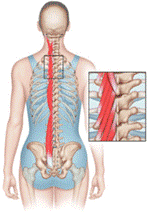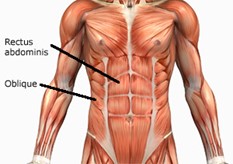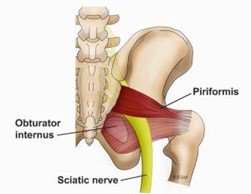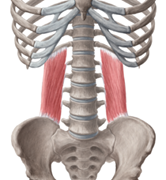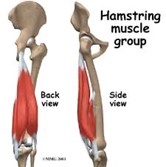Do you find yourself blaming your back pain on your old mattress, your family’s poor genetics, something you just picked up, or the long car ride that you took? Back pain is a multifaceted disorder with many contributing factors causing it to be the largest cause of disability in America. Back pain costs Americans multiple billions of dollars each year, making it one of the most serious health issues that we face today.
It is important for each of us to have a basic understanding of the muscles, joints, and behavior patterns that are involved in this epidemic. In today’s newsletter we want to share with you the common muscles that are responsible for back pain and the activities that cause them to become painful.
Spinal muscles and their roles: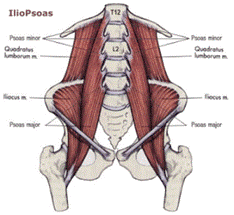
Iliopsoas (psoas + iliacus) complex
These lie deep within the abdomen and hip, connecting the lumbar vertebrae and the iliac crest to the top of the femur. They’re major movers during bent knee leg raises and sit-ups.
Aggravated by: Excessive sitting/driving, lots of kicking (martial arts or soccer), long bike rides in bent position, and sleeping in the fetal position.
These are like the spine’s “suspenders” and help to control rotation, extension and bending. This group includes the erector spinae and multifidus along the spine.
Aggravated by: Sudden spinal overload, repetitive movement with poor technique, hunched posture, tight abdominal muscles, and lots of sitting.
This sheet of muscle is your “washboard abs.” It runs between the lowest ribs and top of the pubic bone, and helps stabilize the torso. Excessive training of the rectus abdominis (at the expense of posterior chain muscles) can diminish the ability to carry weight overhead (think jerks, snatches, overhead presses) and lead to lower back injury.
So: fewer crunches, more swings.
Aggravated by: Too many crunches (especially without posterior chain training), over-exercising, excess abdominal fat, and reliance on weight training belts.
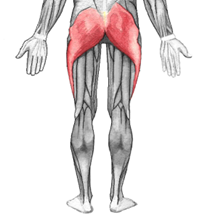 Gluteus group: maximus/medius/minimus
Gluteus group: maximus/medius/minimus
AKA: the booty, these are the muscles that help bring your thigh behind you (think: donkey kicks), rotate it, and bring it to the side.
Aggravated by: Prolonged sitting, sleeping in fetal position with knees pulled up, sitting on your wallet, standing for long periods on one leg, sleeping on your back with feet splayed under the weight of a heavy blanket.
This small muscle lies deep within the glutes and connects the thigh to the pelvis near the sacrum. It rotates the thigh outward and swings the leg to the side when the thigh is flexed.
Aggravated by: Distance running (repetitive overuse in general), prolonged contraction (such as driving a car), sitting with one foot underneath the body, walking with duck feet (toes out), sitting too much.
The “QL” lies deep in the side of the torso around the kidneys. It helps to bend, rotate, and straighten the torso from a bent position. It also helps with exhalation (coughing, etc.). Many folks discover when they strain the QL, they live in constant fear of sneezing.
Aggravated by: Structural imbalances (one leg longer, uneven pelvis, etc.), habitual leaning to one side, slouching, always sleeping on one side.
These big leg muscles run along the back of the thighs, attaching at the hip and the knee. They bend and stabilize the knee.
Aggravated by: Pressure from chairs, prolonged sitting, bed rest, overload (e.g. lots of sprints when a trainee isn’t used to sprinting).
Common Causes of Low Back Pain
Bad Biomechanics:
Back pain only gets worse with poor biomechanics. Most spine injuries that occur are muscle strains or ligament sprains, usually due to improper loading and bending technique. A common error is lumbar flexion during movements like bending, lifting, and squatting. Excessive lumbar extension is also dangerous and can lead to vertebral fracture (e.g. extending the lumbar spine when standing up).
The safest position for the lumbar spine is a neutral position — a natural but not exaggerated S-curve. You can find a neutral spine by flexing your lumbar spine, then extending it and trying to find the midpoint between the two or by standing tall and taking a deep breath. Use a mirror to check.
Weakness:
Many people assume that strong abdominals help them bend and twist. This is true, in part, but most often the core’s role is stability rather than movement — in other words, preventing motion rather than initiating it. Too much flexion or extension at the lumbar spine, usually caused by weak core muscles, can lead to injury. It’s also biomechanically weaker. You can throw a lot farther or punch a lot harder when your hips and shoulders are involved than when you’re just twisting at the waist. Try incorporating these movements into your workout; a wood chop with a cable system is one idea.
Imbalances:
Folks with chronic back pain often neglect the posterior chain (i.e. the muscles that run along the rear of the body from neck to ankles). This is especially true for gym rats who do too much bench pressing and not enough pulling or hip extension. This keeps back problems in full force. Single leg exercises help develop the lower body and immediately challenge the lower back and hips, building stability and function. Try a one legged squat off of 8” step to decrease your hip imbalances.
Sedentary Living:
Doctors used to recommend bed rest for back pain. Now they usually recommend movement. As you can see from the list of muscle problems above, “too much sitting” factors into a host of back problems. When we sit or lie around all day, intervertebral discs absorb fluid and become tighter, allowing less range of motion and promoting injury. Introduce yourself to regular movement (warm ups, yoga, and dynamic joint mobility, along with walking and swimming). These movements will help preserve spinal health.
Look For Help:
Fixing a bad back is a complicated endeavor. Changing bad posture, muscle imbalances, harmful habits, spinal biomechanics issues, and adaptive movement patterns are both time-consuming and difficult to accomplish. The help of a chiropractor trained in the art of helping joints and tissues heal while retraining the muscular stabilization system can be a life changing experience. If you have been thinking of getting to the chiropractor don’t delay! Each new day is a day that you could be closer to a pain-free back and your body’s optimal health.


